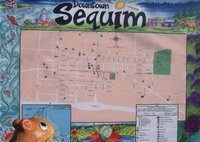
Sequim, WA. A small, self-proclaimed retirement town overlooking the Pacific Ocean and, on a good day, Canada.
A main bus line running down the 101 freeway (on its way to Port Angeles) comprises the majority of the public transportation on four wheels. Trails and walks crossing the town and surrounding farms provide the rest of transportation.
Retirement cities are some of the few places where the number of car-owning, driving citizens is shrinking faster than the teenagers waiting for their driving permits.
In other respects, Sequim is a perfect, quaint ocean town. Surrounded by farms and oceans, one of the main downtown attractions is a public restroom building.
A
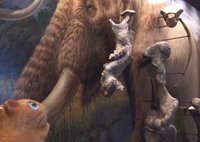 nother is the giant Mastodon, which a resident found while digging a pond in his backyard.
nother is the giant Mastodon, which a resident found while digging a pond in his backyard.I am not entirely convinced that the two are unrelated.
The tusks were the first parts of the Mastodon discovered. They look like a partially cracked, curved tree branch, and both are lying in a covered drinking trough, submerged for preservation.
Since the tusks were discovered underwater, they were in particularly fine condition. So fine that the person who found them didn't recognize them. Well, not at first.
I always love stories like that. On one hand, it seems strange that anyone could miss a bone. Bones are one of those materials (like radioactive waste and kryptonite) which everyone should be able to recognize outright.
On the other hand, if you've ever seen a bone in the ground, next to a piece of driftwood, half-buried, covered in mud, sitting on your kitchen table, or otherwise rendered unrecognizable, you know what every other bone-finder knows. Those things are nearly impossible to spot. And even more impossible to recognize.
So you have to admire someone who was able to, while ticking off an item on his Honey Do list, figure out that an ancient tusk was not a tree branch, and call the proper authorities.
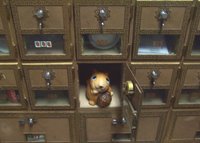
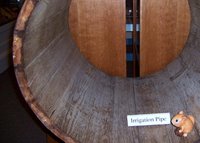 The museum has two other eye-catching permanent exhibits (about seventy-five percent of the exhibit space is rotated in order to accommodate a variety of large exhibits in combination with local art). Both of these exhibits seem to reflect Sequim well to this day.
The museum has two other eye-catching permanent exhibits (about seventy-five percent of the exhibit space is rotated in order to accommodate a variety of large exhibits in combination with local art). Both of these exhibits seem to reflect Sequim well to this day.A cross-section of an old irrigation pipe.
The original Post Office boxes.
Irrigation has always been extraordinarily important to Sequim. The city and surrounding areas are both surprisingly temperate and nearly rain-free. Despite what you may think of the Washington/Seattle area, there was hardly a cloud - and certainly not a drop - in the sky during my entire visit.
The original Post Office boxes speak volumes. Not simply because no one today remembers the combinations for the doors to the safety deposit boxes, but also because Sequim has nearly always had the problem I am sure many of are having already with its name.
How would you pronounce "Sequim"? Do you think you could pass the spelling bee if asked to stand up there and recite?
When the town was first created, the USPS couldn't even spell the postmark correctly. Letters arrived or were sent addressed to "Seguin", "Sequin", and "Segun". These letters still found their way. Or so the Visitor Center/Museum would have you think).
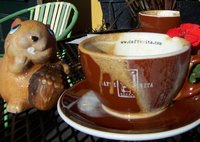 But the dawn of the Washington coffee age (think: Starbucks) helped to resolve both problems.
But the dawn of the Washington coffee age (think: Starbucks) helped to resolve both problems.(Local, delicious coffee provided by The Beehive, with nary an obscure reference to Moby Dick in sight)
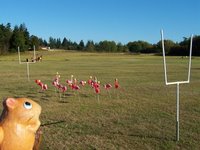 Or, maybe the caffeine simply contributes to their lawn ornaments playing major contact sports on the side of the freeway, without being overly productive in the process.
Or, maybe the caffeine simply contributes to their lawn ornaments playing major contact sports on the side of the freeway, without being overly productive in the process.I believe the yellow tennis-ball helmets were winning 21-13 when this picture was taken.
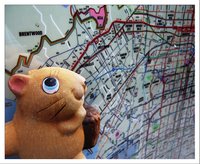

No comments:
Post a Comment